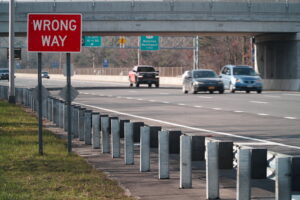In 2022, 23 people died in Connecticut wrong-way accidents. Most wrong-way crashes reported involved a driver with a BAC (blood alcohol content) of 0.08% or more.
While these are not the most common types of car accidents in the state, they are seen more often than many realize.
If you are involved in a wrong-way accident, you have rights. We encourage you to contact our Connecticut car accident lawyers at Jonathan Perkins Injury Lawyers for assistance.
Here you can learn more about wrong-way accidents, how they occur, and how to prevent them.
How and Why Do Wrong Way Accidents Occur?
Medians and other barriers are used between lanes to help create a boundary and prevent wrong-way driving. However, some motorists still wind up going the wrong way.
On local roads, drivers may not see the signs or could drift over the line and into the opposite lane. While wrong-way accidents make up just three percent of accidents (on average) across the U.S. each year, they still present a serious problem. This is because the injuries from these collisions can be severe and include things like broken bones, TBIs (traumatic brain injuries), abdominal injuries, paralysis, and death.
While drivers often travel on the wrong side of the road because they are intoxicated, other factors may play a role in these accidents, too, which include the following:
- Fatigued or distracted driving may cause a driver to miss signals, changing traffic patterns and important signage. This may cause the driver to go in the wrong direction on a one-way street.
- Drivers over 70 are responsible for around 15% of wrong-way accidents. Medication or vision issues can make road design and signage confusing and unclear, while memory-related problems, like dementia, may make drivers forget where they are.
- Younger drivers also present a higher risk of wrong-way accidents because they are typically more focused on the road than the conditions around them.
- Road design can create confusion for some drivers, especially those new to the area. Examples include dimly lit streets, unreadable or missing signs, and poorly marked ramps.
- Road conditions may impact how well drivers can see lines and signs. Wrong-way accidents are more likely to occur at night or during rain, snow, dust storms, or fog.
- Many drivers rely on GPS to get around, and while these systems offer guidance about turns and directions, if a driver is unfamiliar with the area, they may travel the wrong way down a one-way street or make an illegal turn or U-turn.
- Confusion around detours can occur, especially when the typical traffic pattern is different and the signs are unclear about what to expect.
Common Injuries from Wrong-Way Accidents
Up to 20% of wrong-way accidents involve a fatality. For those who survive the collision, the injuries may be life-changing and cause serious complications that require ongoing rehabilitation.
Some of the most common injuries seen in wrong-way accidents include the following:
- Broken bones
- Traumatic brain injuries
- Chest injuries
- Internal abdominal injuries
- Full or partial paralysis
- Spinal cord injuries
- Whiplash
Why Are Wrong Car Accidents So Deadly?
If you compare the fatality rates of wrong-way accidents and other crashes, you will see the first results in more deaths, more often.
The question is – why is this the case? Why are wrong-way accidents more fatal than other collisions?
Some factors have been determined that lead to this trend.
Wrong-Way Collisions Are Usually Head-On Accidents
One of the top reasons that wrong-way accidents are often fatal is that they are usually head-on collisions. These crashes lead to fatalities because there is no time for those involved to react to or prevent the accident.
When you see a car in front of you about to hit you, you do not have time to change course, stop, or avoid the incident. You may not even be able to veer out of the way.
Also, head-on collisions often result in the driver absorbing the crash’s impact, and the odds of living through it are reduced significantly when exposed to the accident’s impact.
Wrong Way Accidents Often Involve Older Drivers
Studies have shown that older drivers are commonly involved in wrong-way accidents. In fact, many drivers over age 70 are involved in these collisions.
The determination of some physical capabilities puts senior drivers at more risk. Also, the chances of fatalities increase because they will probably not survive major complications or injuries.
Let Our Legal Team Help After a Wrong Way Accident in Connecticut
If you are involved in a wrong-way accident in Connecticut, our legal team at Jonathan Perkins Injury Lawyers is here to help. We can review the facts of your case and injuries to help determine the value of your claim.
Our goal is to help you recover the most compensation possible for your accident and help you recover from the injuries you sustained.
The first step is to call our office to schedule a free consultation. We are ready to help you with your claim.
Read More
How to Win Reckless Driving and Connecticut Car Accidents Claims

